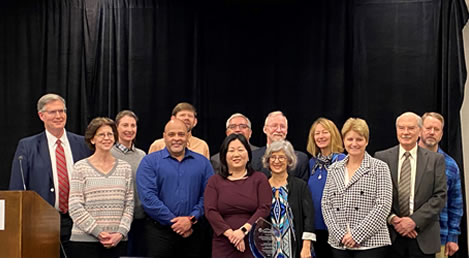
The winner of the 2024 Safe-in-Sound Excellence in Hearing Loss Prevention Award™ is The Dow Chemical Company. The Dow Chemical Company is an American multinational corporation with 100 manufacturing locations in more than 30 countries. It employs over 35,000 people worldwide. It is recognized for its commitment to finding and implementing solutions to high noise and communication challenges in their facilities and exploring innovative, leading-edge best practices. An awareness-raising effort to change a culture that had not previously prioritized noise among its operation improvement efforts triggered many successful interventions. Initial successful noise control and hearing loss prevention actions, along with testimonials from workers across the corporation on issues related-to noise exposure, hearing difficulties, stress and communication challenges motivated further work. Support and enthusiastic buy-in from all levels of the corporation followed and noise solutions became prominent in the Global Improvement agenda and the Total Worker Health efforts. Individual facilities can apply for financial and technical support for solutions tailored to their needs and were held accountable to share results with other teams. The overall strategy included identifying high priority noise risks (using the recommended exposure level of 85 dBA, 3-dB exchange rate), using them to make a case for change, set goals to fix the problems and tracking progress over time. In addition, they implemented better hearing protection (custom molded plugs, integrated communication devices, and smart plugs for targeted groups, fit-testing and expanded training while long term fixes were completed. They have developed and are executing a truly exemplary hearing loss prevention program.
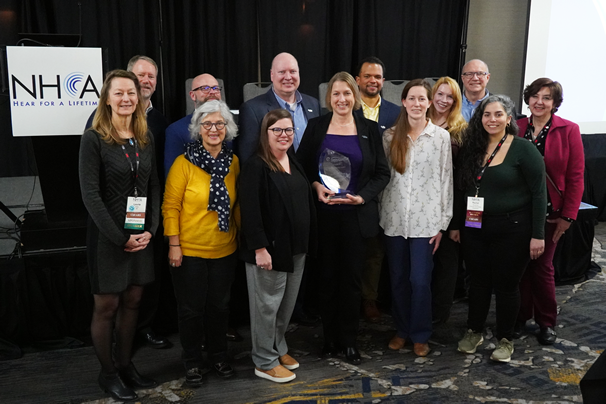
From L to R back: Ted Madison (Safe-in-Sound Committee), Ben Davidson, Matt Sczepanski, Rassull Suarez, and Karen Study (Dow),
Andy Merkley and Monica Janzen-Holverson (CAOHC)
From L to R front: Laurie Wells and Thais Morata (Safe-in-Sound Committee), Jessica Miller, Sara Joswiak and Grace Battista (Dow),
Rachel Bouserhal (NHCA)
Dow Safe in Sound Awards Video
Exellence in Hearing Loss Prevention Dow Presentation 2024 (PDF Reader Required)
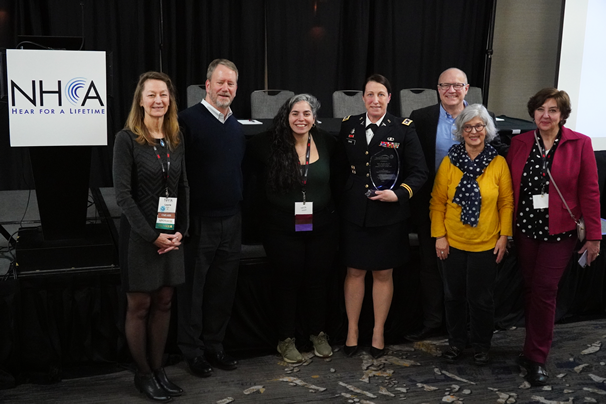
From L to R: Laurie Wells and Ted Madison (Safe-in-Sound Committee), Rachel Bouserhal (NHCA), Kara Cave (U.S. Army),
Andy Merkley (CAOHC), Thais Morata (Safe-in-Sound Committee) and Monica Janzen-Holverson (CAOHC)
LTC Kara Cave Safe in Sound Awards Video
Innovation in Hearing Loss Prevention LTC Kara Cave, U.S. Army, Fort Liberty, North Carolina (PDF Reader Required)
The 2022 recipient for Excellence in Hearing Loss Prevention is:

The 2022 recipient for Excellence in Hearing Loss Prevention in the Manufacturing Sector is the Northrop Grumman St. Augustine Site, in Florida. The Center includes 151 acres and 38 buildings of office and warehouse space. This facility produces, modifies, repairs and overhauls military aircraft and employs about 1,100 workers. Their accomplishments in hearing loss prevention can be attributed to the company’s strong safety culture, outstanding leadership, continuous innovation, adequate resources, as well as continuous operational improvements. They have demonstrated excellence in several areas of hearing loss prevention, including: ongoing noise monitoring (triggered by changes in tools, processes, or employee request); implementing noise controls; adopting buy-quiet strategies in the purchase of new equipment and tools; providing several alternatives of hearing protection devices and hearing protection fit-testing with accompanying individual, periodic training; providing state-of-the art communication-enhanced electronic hearing protection devices, as needed; carefully reviewing and analyzing of pure tone audiometry results aiming to identify early changes, and finally; continuously improving their training to ensure relevance. Employees at all levels are engaged in the initiatives. Northrop Grumman’s mission of maintaining the highest quality of workmanship in everything they build recognizes that the health of the environment and the employees are fundamental parts of their strategy.
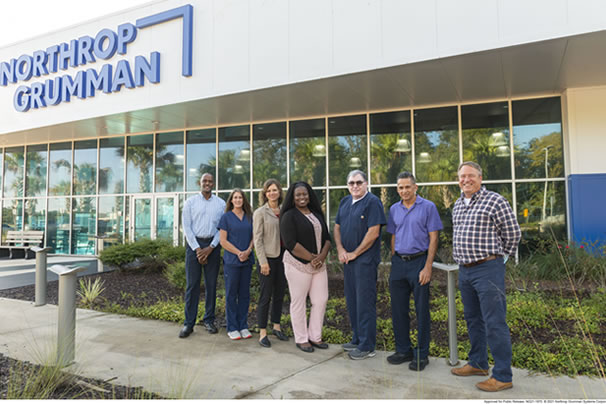
Left to Right: Adrian Brown, Tami Hays, Julie Edwards, Gina Williams, Quinn Soudrette, Javier Garcia, Gavin Murray Sr., Russ Cart (not shown). James Hall (not shown)
Northrop Grumman Video
Exellence in Hearing Loss Prevention Northrup Grumman Presentation 2022 (PDF Reader Required)
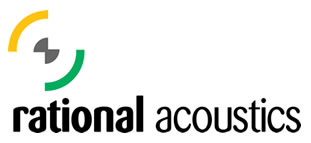
The 2022 recipients for Innovation in Hearing Loss Prevention are Michael Lawrence, Jamie Anderson and Rational Acoustics LLC. Michael Lawrence is a senior instructor for Rational Acoustics, product manager, freelance system engineer and audio journalist. Jamie Anderson is its president, owner, and director of training. Rational Acoustics LLC is a New England based software company that develops, distributes, and supports audio measurement software for the worldwide professional sound industry. It is a small company established in 2008, focused on measurement of audio output at music events, and currently their main primary product is Smaart® measurement software, now in its 8th version. Their focus goes beyond product development. They have addressed the compounding issues related to risks of overexposures to music experienced by live sound mixers, event crew and attendees of concerts. These issues include a lack of tools for accurately measuring sound pressure and obtaining data in an actionable format; lack of knowledge of risk and/or fatalism towards risks; an unregulated environment; and resistance towards the implementation of best practices guidelines. Their innovative approach addresses all these issues, and includes: developing a product that provides sound engineers with actionable data, remote monitoring, and alerts during performances; a robust volunteer outreach and education strategy that encompasses publications, curriculum development; providing tools for other trainers and participating in guidance development with several professional organizations; and creating materials, developing and teaching mixing techniques to increase loudness/impact without increasing exposure. The recipients are recognized for being pioneers in combining products, services, and education to reach their hearing health promotion, for their culture of innovation and educational outreach, and for having raised awareness of the importance of managing music exposures among music industry professionals, standard setting organizations and the general public.

Left to Right: John Aldrich, Michael Lawrence, Chris Tsanjoures, Jamie Anderson
Rational Acoustics Video
Innovation in Hearing Loss Prevention Rational Acoustics Presentation (PDF Reader Required)
The 2021 recipient for Innovation in Hearing Loss Prevention is:

The 2021 Safe-in-Sound Award for Innovation is being presented to the team Vertical Lift, AH-64 Apache Helicopter of the Boeing Company in Mesa, Arizona. In 2012 a Safety Champion program was instituted to get worker involvement in making safety improvements. The Apache helicopters have an environmental control unit that created noise levels of 84- 104 decibel, including a very high pitch whine that impacted the entire building. Production employees and in-house engineers at Boeing worked together to develop a noise suppression kit or “hush kit” to reduce noise levels generated by the testing of Apache helicopters. The kit consists of a baffled box which seats snug against the exhaust outlet. This cost-effective solution reduced noise levels by 50- 72% to 85 dB or less at 5 feet from the source. Other Boeing facilities are looking to institute similar interventions and participatory safety programs.
Boeing Innovation Award 2020 (PDF Reader Required)
View the Safe in Sound 2021 Award for Innovation in Hearing Loss Prevention Video Here
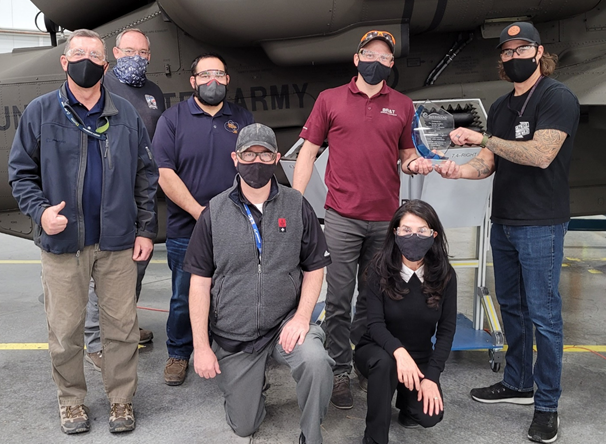
Left to Right (Front Row) - Stuart Lange, Production Manager Flight Test; Eric Knutesen, Experimental Flight Test; Parvin
Wallum,
Industrial Hygienist, Hearing Conservation Program Coordinator Left to Right (Back Row) Chris Allen, Apache Delivery Center;
Israel Limon, Manufacturing RChampion)esearch & Development Technician; Jason DeStories, Manufacturing Research & Development Engineer;
Talmadge Ryan-III, Repair/Mod Technician (Safety)
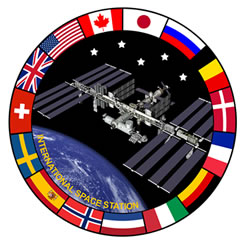
The 2020 recipient for Innovation in Hearing Loss Prevention is the Multilateral Medical Operations Panel’s Acoustics Sub-Working Group for the International Space Station (ISS). The ISS is a unique work environment, which required the development of a series of innovative interventions. Approximately 250 astronaut and cosmonaut visits to Space Station have taken place. Crewmembers are exposed to noise 24 hours a day, seven days a week, with current missions averaging 6 months in duration. Concerns over noise exposure are not restricted to risks to hearing effects, but also to crew health and performance in the form of interference in sleep and communication, and reduced alarm audibility. The Acoustics Sub-Working Group manages the acoustic environment on the International Space Station and protects the hearing of those who work at the station. They work with the astronauts to monitor noise levels on the Space Station, identify noisy tasks or equipment for their Noise Hazard Inventory, test equipment for noise levels before it is sent to the ship, develop and implement solutions to reduce noise levels, recommends hearing protective devices to reduce crew noise exposures and perform audiometric testing before, during (on-orbit) and after flights. No persistent mission-related hearing threshold shifts among US Orbital Segment crewmembers have occurred in the almost 20 years of the ISS operations. This success is the result of the efforts of the acoustical engineers, audiologists, industrial hygienists, and physicians who comprise the subgroup’s membership from NASA, the Russian Space Agency, the European Space Agency, the Japanese Aerospace Exploration Agency, and the Canadian Space Agency. Through this extraordinary program, the astronauts are truly Safe-in-Sound.
NASA Video
Multilateral Medical Operations Panel’s Acoustics Sub-Working Group for the International Space Station (PDF Reader Required)
Front row: Linda Hess (NASA-Johnson Space Center), Jose Limardo (NASA-Johnson Space Center), Ann Nakashima (Canadian Space Agency/ Toronto Research Centre), Thais Morata (NIOSH), Amy Blank (NHCA), Dennis Driscoll (Safe-in-Sound)
Members of the sub-working group not in the photo:
European Space Agency (ESA) European Astronaut Centre: Filippo Castrucci, Lothar Mies
ESA/ European Space Research and Technology Centre: Torben Henriksen
ESA/ Thales Alenia Space Italia: Roberto Ulio, Stefano Destefanis
Japan Aerospace Exploration Agency: Kaz Shimada, Go Suzuki, Tamiyasu Shimamiya, Naoko Baba, Yuhei Yamamura, Toshinori Satoh
Khrunichev Space Center: Stanislav Zaytsev, Vladimir Litovko
NASA/Ames Space Center: Durand Begault
NASA/Johnson Space Center: Mike Misiora, Kae Parker
RSC-Energia: Vladimir Dementiev, Olesya Beda
Russian Institute of Biomedical Problems: Irina Kutina, Eduard Matsnev
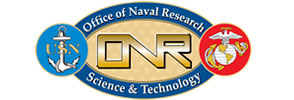
Kurt Yankaskas of the Office of Naval Research (ONR) and the Noise-Induced Hearing Loss (NIHL) Research Program. Approximately one in four sailors suffer from NIHL. The Noise-Induced Hearing Loss (NIHL) Research Program adopted a systems approach which is its innovative foundation. The approach taken maximized the use of various funding strategies within Department of the Navy and DoD and not only expanded partnerships, but also fostered collaborations among principal investigators. The program funds a wide portfolio of research including: on noise control for ships, aircraft and equipment; NIHL surveillance and risk evaluation; medical treatment of NIHL; and improved hearing protection for Navy personnel. The NIHL Program was the first Department of Defense (DoD) program to list tinnitus as an area of basic research. Creative solutions for difficult problems like ship noise control have been developed from work funded by the research portfolio. Some of the innovations include provision of advanced hearing protection to over 6,000 sailors, provision of a flight deck helmet with custom hearing protection, communications system and dosimetry to Aircraft carrier flight deck personnel, and noise control solutions that directly benefitted over 1,400 Sailors who sleep and work directly under the flight deck. These evidence-based solutions have been implemented in the field and undergo continuous, rigorous evaluation. The program’s focus on the costs of both NIHL and tinnitus to the Navy have led to a unique program emphasis on preventing “auditory injury.” Other innovations include the Warfighter’s Hearing Health Instructional Primer (WHIPP) training app and Designer Noise, a program for computer-aided design of ships to include noise control features. While this pioneering portfolio has the primary objective to benefit service personnel, the research results are directly applicable to the civilian world and led lead to the transfer of technologies and interventions to general industry. The accomplishments of Kurt Yankaskas and the Noise-Induced Hearing Loss (NIHL) Research Program are numerous and significant.
Kurt Donald Yankaskas & the Noise Induced Hearing Loss Program of the
Office of Naval Research
(PDF Reader Required)
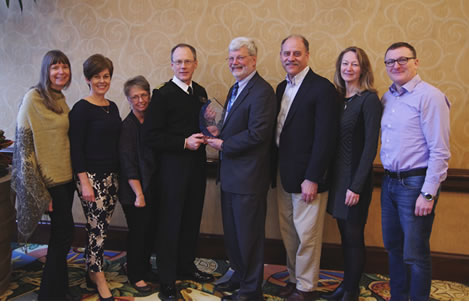
L to R: Deanna Meinke (Safe-in-Sound Committee), Kristy Casto, (Safe-in-Sound Committee); Vickie Tuten (NHCA President), David Byrne (NIOSH), Kurt Yankaskas (Office of Naval Research), Scott Schneider (Safe-in-Sound Committee); Laurie Wells (Council for Accreditation in Occupational Hearing Conservation, Safe-in-Sound Committee), Rick Neitzel (Safe-in-Sound Committee).
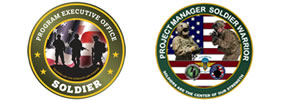
The U.S. Army’s Tactical Communications and Protective System program supports the mission of the Program Executive Office – Soldier (known as PEO-Soldier) to develop, acquire, field, and sustain affordable integrated state-of-the-art equipment to improve Army operations. Since the TCAPS program establishment in 2014, nearly 30,000 active hearing protective systems have been fielded to fifteen Brigade Combat Teams across the Army. Establishment of the TCAPS program granted responsibility and authority to evaluate, select, procure, and field commercially-available off-the-shelf Hearing Protection Devices (HPDs) to designated dismounted Infantry Soldiers, representing about 20-25% of the total active Army. This new possibility triggered the need to develop new and innovative procedures to evaluate, select, procure, deliver and train users on new active hearing protection devices, with the main objective being the simultaneous maintenance of auditory situation awareness and protection from noise-induced hearing loss. A second objective and key to the success of the program was to restore Soldiers’ confidence in hearing protection devices; that is, to restore the confidence that hearing protective devices are an asset and not a liability in training or on the battlefield. In preparing the nomination for Safe-in-Sound, TCAPS representatives described not only their accomplishments, but also many ways in which they continuously evaluate their interventions and possibilities to improve them. Their commitment to their goals, their organizational teamwork and flexibility is especially noteworthy in this high volume, time-critical work environment. The TCAPS Program has had a direct impact on individual Soldiers’ hearing readiness and collective combat effectiveness.
U.S. Army’s Tactical Communications and Protective System Program (PDF Reader Required)
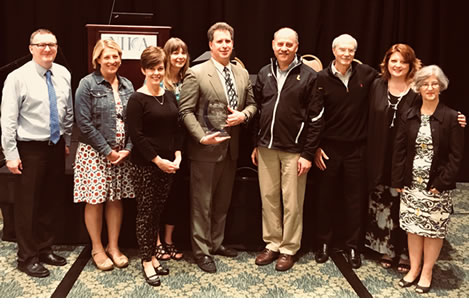
L to R: Rick Neitzel (Safe-in-Sound Committee); Stephanie Griffin (Safe-in-Sound Committee); Kristy Casto, (Safe-in-Sound Committee); Deanna Meinke (Safe-in-Sound Committee), Collin Drennen (TCAPS, U.S. Army) , Scott Schneider (Safe-in-Sound Committee); Dennis Driscoll (Safe-in-Sound Committee); Colleen LePrell (NHCA President), Thais C. Morata (NIOSH).

Ryan Lee Scott, Deputy Sheriff, Alachua County Sheriff’s Office, FL. Deputy Sheriff Scott recognized the potential risk that shooting firearms during qualification training posed to his ability to hear, and the need for effective hearing loss prevention strategies and training for police officers. He sought guidance from a faculty team at the University of Florida to learn about the high-level impulse sounds produced by firearms and interventions to minimize the risk. The new knowledge motivated him to develop an educational workshop: “Firearms Training and Hearing Loss” tailored specifically to the law enforcement community. The workshop covers the potential for unprotected firearm sounds to damage their hearing, and the use of specialized hearing protection devices and firearm suppressors to reduce the sound levels. Deputy Sheriff Scott engages attendees with his own real-world real-life career and training experiences. His commitment is even more noteworthy as he has invested both his personal time and money to voluntarily develop, travel and deliver his training sessions. He has also become an advocate, working to increase the availability of technological solutions and devices that integrate hearing protection with radio communication systems, so that situational awareness is preserved for those whose hearing is critical to job performance and safety. Towards that goal, he has reached out to a variety of stakeholders, including public safety officers and supervisory administrative teams responsible for acquisition and purchasing decisions. Deputy Sheriff Scott’s initiative and leadership efforts to promote hearing loss prevention and dissemination of evidence-based information on this topic demonstrate his true passion and commitment to reducing the effects of noise among the underserved law enforcement community.
Sound Prevention Law Enforecement Solutions (PDF Reader Required)
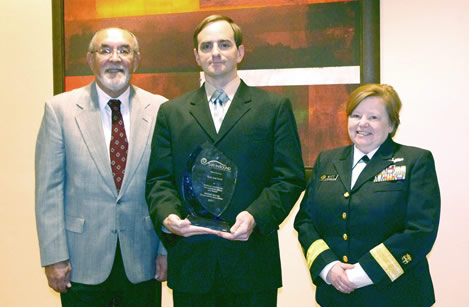
From left to right: James Jerome (NHCA President), Deputy Sheriff Ryan Lee Scott (Alachua County Sheriff’s Office, FL) and RADM. Margaret Kitt (Deputy Director, NIOSH).
![]()
3M has 180 plant locations worldwide which produce over 50,000 products. The 3M Alexandria plant produces a variety of industrial abrasives products used to grind, blend, polish, sand, prep, cut, clean or repair surfaces. These materials are used for metal fabrication, precision castings, cylindrical grinding, furniture and custom wood, automotive manufacturing, maintenance and more. The environmental health and safety staff and workers at 3M Alexandria are the 2016 recipient of the Safe-in-Sound Excellence in Hearing Loss Prevention Award™ in manufacturing. Starting in November 2011 3M Alexandria received corporate support to reduce noise exposures and the need for their workers to be enrolled in a hearing conservation program throughout their facility. Noise exposures were so successfully reduced (12 - 14 dBA across 24 different areas and departments), that 199 of 203 employees were no longer required to be included in the 3M Alexandria Hearing Conservation Program. Their initiatives are recognized for the all-inclusive and systematic, statistically driven noise exposure assessments, cost-effective noise reduction projects, the documentation of cost and noise reduction results, and the implementation of Buy-Quiet principles. In addition, 3M Alexandria has maintained a high quality audiometric testing and hearing protection selection and fitting program for those few employees that remain exposed to noise. 3M Alexandria’s success story demonstrates that noise control is desirable, achievable, and economical in both short and long term.
3M Alexandria Hearing Conservation Program (Adobe Acronat Reader Required)
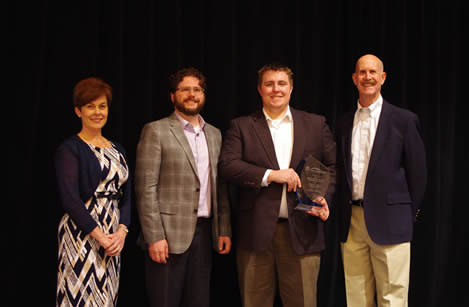
(From left to right): Kristy Casto (NHCA), Carl Johnson (3M Alexandria), Matt VanWatermulen (3M Alexandria), John Howard, NIOSH
![]()
John Casali is the John Grado Professor at Dept. of Industrial and Systems Engineering, Director, Auditory Systems Laboratory, Virginia Tech (Blacksburg, VA), Past-President, National Hearing Conservation Association, 2009 NHCA Outstanding Hearing Conservationist recipient, and co-chair of the 1995 NHCA-NIOSH joint hearing conservation conference. John Casali and Virginia Tech are the 2016 recipients of the Safe-in-Sound Award for Innovation in Hearing Loss Prevention for their pioneering, extensive and innovative efforts in hearing protection research and auditory signal detection. The work of the Auditory Systems Laboratory is unique in that it combines human factors engineering with acoustics and audiology to solve research questions in many aspects of auditory perception and hearing health. The areas of research are broad based and include: auditory situation awareness for military and industrial applications, improved hearing protector design and evaluation, warning signal design and effectiveness, speech communications in noise, auditory requirements for specific job duties, signal detection and noise reduction in aircraft cockpits, integration of various items of personal protective equipment (interoperability) and noise annoyance in communities. The impact of their work extends beyond hearing loss prevention into safety. Their initiatives to study the user's ability to hear, perceive, and respond to important auditory stimuli in their environments -- that is, the ability to maintain "Auditory Situation Awareness" are recognized as innovative and broad reaching, and are considered critical to the improvement of hearing protection devices and the safety of their wearers. The ultimate beneficiaries of this work are primarily military personnel, but also workers in jobs which impose hazards that stem from not being able to hear important signals and communications. John Casali’s example and leadership instills a culture of scientific rigor, precision, and attention to detail that contributes to practical solutions in the real world of hazardous noise exposures.
Prof. John Casali Presentation on Innovation (PDF Reader Required)
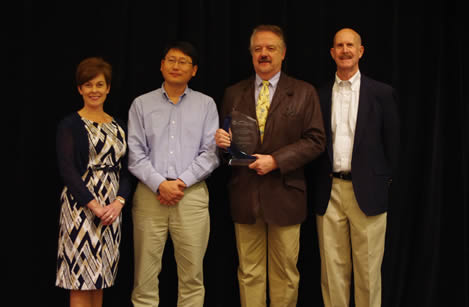
(From left to right): Kristy Casto (NHCA), Kichol Lee (Virginia Tech), John G. Casali (Virginia Tech), John Howard, NIOSH
![]()
United Technologies Corporation (UTC) is a global company with over 210,000 employees from 46 states and 186 countries. This is only the second time that a Safe-in-Sound Excellence Award™ is presented to an entire corporation and represents an example of excellence across multiple industries and geographical locations. UTC is recognized for including in its current sustainability goals “to reduce employee exposure to noise and chemicals to levels so safe that wearing personal protective equipment is no longer mandatory….” and for the subsequent multi-level strategies used to support the diverse companies within the corporation to fulfill that goal. Their comprehensive approach to hearing loss prevention and commitment to employee hearing health and noise control are exceptional. Their approach includes corporation-wide interventions such as: reduction of sound levels below an 85-dBA limit for 8-hour noise exposures; adoption of inclusive criteria in their comprehensive hearing loss prevention program; completion of multiple noise-control studies throughout each business unit to identify all noise sources affecting worker exposure; documentation of cost and noise reduction results; and the adoption of Buy-Quiet policies and practices. Employees at all levels of the corporation are engaged in the initiatives and each individually contributes to these noteworthy accomplishments.
United Technologies Corporation (UTC)Presentation (PDF Reader Required)
![]() Click here for the podcast
Click here for the podcast
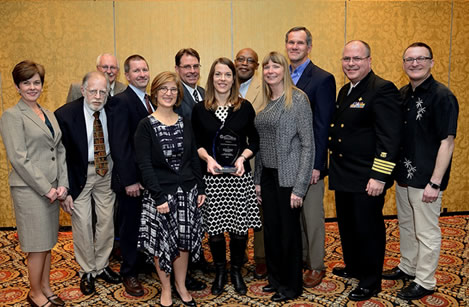
Back row, from left to right: James Lankford (Safe-in-Sound Committee), Matthew Twerdy (UTC);
Phillip Sims (UTC), Mike Nightingale (UTC), Front row, L to R: Kristy Casto (NHCA President),
John Franks, (Safe-in-Sound Committee), David Senft (UTC), Thais C. Morata (NIOSH), Sara Kerr (UTC),
Deanna Meinke (Safe-in-Sound Committee), William Murphy (NIOSH), and Rick Neitzel (Safe-in-Sound Committee).
![]()
Mahrt Mill Employees of Cottonton, Alabama, of the MeadWestvaco Corporation. The intrinsic nature of the noise hazards at a paper mill approaching its 50th anniversary makes them difficult to control, which translates into challenges and elevates the importance for the other hearing loss prevention efforts. The subsequent reliance upon hearing protection and effective training becomes even more critical when hazardous noise levels exist. In addition, recognition of the importance of audibility and communication that is critical to employee safety is also a relevant consideration. The Mahrt Mill Hearing Conservation Team expanded and improved on their noise measurements, developed and implemented engaging educational programs, provided two alternative types of hearing protection fit-testing of all plant personnel, selected a diverse assortment of effective general and specialty hearing protection devices for both work and recreational application, conducted high quality audiometric testing with professional review and employee follow-up. There is evidence of strong support from plant management and individual workers and each recognizes their role in the success of the program. Their teamwork commitment to each individual at risk of noise-induced hearing loss and tinnitus is especially noteworthy, as are their efforts to actively encourage the adoption of their strategies by other MWV sites. The employees of Mahrt Mill are changing their course towards hearing health.
Mahrt Mill (MM) Presentation (PDF Reader Required)
![]() Click here for the podcast
Click here for the podcast
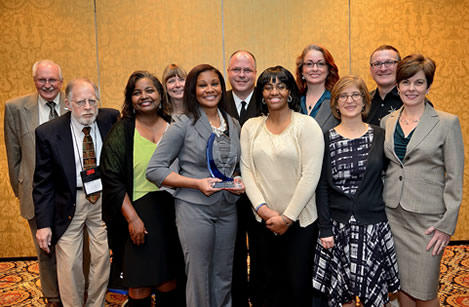
Back row, from left to right: James Lankford (Safe-in-Sound Committee),
John Franks (Safe-in-Sound Committee), Deanna Meinke (Safe-in-Sound Committee),
William Murphy (NIOSH), Hazel Ladner (MWV), Rick Neitzel (Safe-in-Sound Committee);
Front row, L to R: Rosolyn Durden (MWV), Courtney Tinner (MWV), Cathy Porter (MWV),
Thais C. Morata (NIOSH), and Kristy Casto (NHCA President).
Northrop Grumman Systems Corporation, Electronic Systems Sector, from Linthicum, Maryland. Northrop Grumman Electronic Systems (NGES) is a developer, manufacturer, integrator and supporter of advanced electronic and maritime systems for U.S. and international customers for national security and non-defense applications. These systems include high performance sensors, intelligence processing and navigation systems that range from radar and targeting systems to tactical ground stations and navigation systems, and are designed to operate in all environments from undersea to outer space. The Electronic Systems Sector headquarters employs 4000 employees in Linthicum, MD. Northrop Grumman Electronics Systems is being recognized for their commitment and implementation of hearing loss prevention strategies in a highly unique and challenging work environment. Specifically, NGES has implemented a process to identify and effectively control hazardous noise sources that have reduced or eliminated individual worker daily noise exposures and the need for most of their workers to be enrolled in a hearing loss prevention program. However, this has been implemented judiciously; employees are proactively enrolled in the hearing loss prevention program when noise sources cannot be fully controlled. The program components include; individualized training, hearing protector fit-testing and audiometric monitoring to assure workers are adequately protected. Northrop Grumman Electronic Systems is also recognized for their vision in developing a community outreach program for employees and their families. This initiative extends their efforts to prevent noise-induced hearing loss and tinnitus beyond the workplace, and addresses non-occupational noise hazards as well.
Northrop Grumman(NG)Presentation (PDF Reader Required)
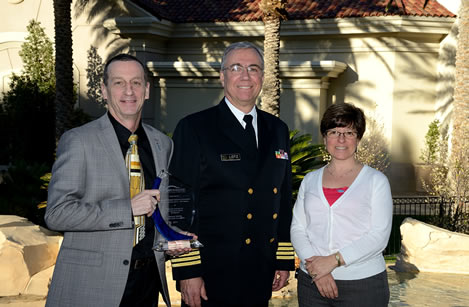
From Left to Right: Kevin O’Connor (NG), Greg Lotz (NIOSH) and Nancy Hall (NG)
Benjamin Kanters and “HearTomorrow” at Columbia College Chicago (Chicago, IL). Benjamin Kanters, Founder of “HearTomorrow” is an Associate Professor at Columbia College Chicago where he teaches a course entitled “Studies in Hearing” addressing hearing physiology, disorders and conservation for students studying audio engineering and acoustics. In 2008, this course became the foundation for “The Hearing Conservation Workshop” which is designed to teach hearing awareness and conservation to students and professionals in the audio, music and hearing science industries. Benjamin Kanters is being recognized for his development and widespread dissemination of the 2-hour seminar which has been delivered at 37 colleges and universities, 23 professional conferences and as an online webinar. His passion for hearing loss prevention is tangible and positively promotes the need to educate the music and audio engineering community and those who provide hearing healthcare to theml.
Hear Tomorrow (HT) Presentation (PDF Reader Required)
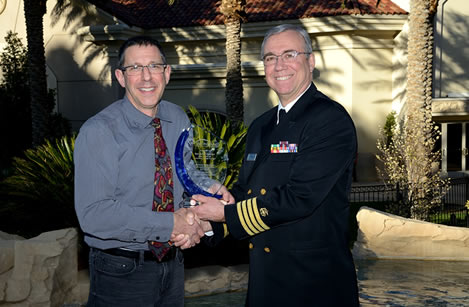
From left to right: Benjamin Kanters (Columbia College Chicago) and Greg Lotz (NIOSH)
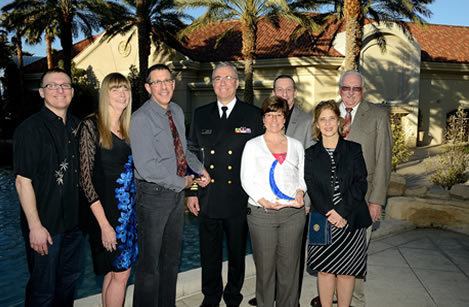
From left to right: Rick Neitzel (Safe-in-Sound Committee), Deanna Meinke (Safe-in-Sound Committee), Benjamin Kanters (Columbia College Chicago), Greg Lotz (NIOSH), Kevin O’Connor (NG), James Lankford, (Safe-in-Sound Committee); Front: Nancy Hall (NG) and Thais C. Morata (NIOSH).
Vulcan Materials Company (VMC) is a major producer of construction aggregates; primarily crushed stone, sand and gravel. VMC operates 323 aggregates plants and other production and distribution facilities which serve 19 states, the District of Columbia, the Bahamas and Mexico. In 2011, VMC shipped approximately 143 million tons of construction aggregates, and also provided asphalt mix, ready-mixed concrete and paving construction services. VMC was recognized for their commitment and implementation of a quality data-driven hearing loss prevention program that extends beyond simple regulatory compliance. VMC’s effort is especially noteworthy when one considers the diverse and ever-changing and challenging work environments that are characteristic of this industry. VMC has embraced innovative and cost-effective noise measurement and control strategies. Noise risks are prioritized and addressed systematically with careful attention to detail to assure prompt reporting, high quality data, detailed analysis, progress tracking and outcome assessments. VMC provides extensive noise measurement and control training and re-training for select employees to function as industrial hygiene support staff. This allows VMC to increase their noise hazard surveillance and intervention opportunities without sacrificing quality. VMC’s is also leading the advancements in noise monitoring strategies for mobile workers by integrating sophisticated technologies such as GPS, and video into their noise measurement protocols. These novel approaches will benefit other industries in the future and contribute to the goal of eliminating occupational noise-induced hearing loss.
Vulcan Materials Company (VMC)Presentation (PDF Reader Required)
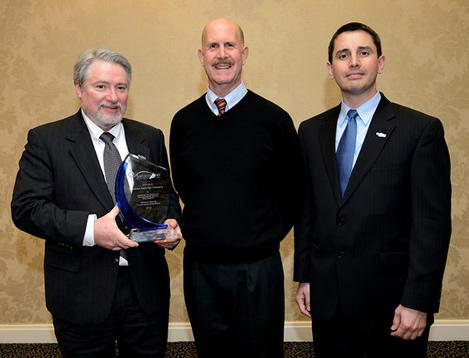
From L to R: Kelly Bailey (VMC), John Howard (NIOSH), Andrew Perkins (VMC). Photo Courtesy: Jack Foreman
Johns Manville (JM), a Berkshire Hathaway company, is a leading manufacturer and marketer of premium-quality building insulation, commercial roofing, roof insulation, and specialty products for commercial, industrial and residential applications. JM employs 6500 employees in the U.S., Europe and Asia. JM was recognized for their development and application of innovative hearing loss prevention program metrics. Their “Hearing Conservation Pyramid” approach incorporates both leading and lagging indicators of hearing conservation program effectiveness. Rather than an injury-based focus which relied solely on the traditional significant threshold shift (STS) metric and Occupational Safety and Health Administration (OSHA) recordable hearing loss cases, JM has integrated three other metrics. These additional metrics include an early audiometric notch index, hearing protector personal attenuation ratings and a noise level index designed to track noise exposure levels weighted by FTEs. The implementation of the JM “Hearing Conservation Pyramid” approach initiated noise control engineering training which ultimately resulted in the completion of successful noise control projects and stimulated resource sharing between plants. The JM revised metric approach has been enthusiastically embraced by both plant managers and employees due to their ability to directly impact the noise exposure of workers. This innovative JM data driven approach has demonstrated practical implementation in the short-term and will provide for long-term program monitoring and advocacy. The JM “Hearing Conservation Pyramid” is readily adaptable to other noise-exposed industries who wish to become proactive rather than reactive to the risk of noise-induced hearing loss among their workforce.
Johns Manville (JM), a Berkshire Hathaway Company Presentation (PDF Reader Required)

From L to R: Jeanne Virtue (JM), Barbara Menard (JM), John Howard (NIOSH). Photo Courtesy: Jack Foreman
Dangerous Decibels® is a multi-faceted, evidence-based intervention program dedicated to the prevention of noise-induced hearing loss and tinnitus. The Dangerous Decibels program has been built upon collaborative partnerships between the Oregon Health & Science University, the Portland State University, the University of Northern Colorado and the Oregon Museum of Science and Industry with widespread funding and dissemination support by numerous organizations. Dangerous Decibels was recognized for their development, widespread dissemination and cultural adaptation of innovative training strategies shown to positively change knowledge, attitudes and behaviors in youth and adults. The program is unique in terms of the solid scientific and theoretical basis which incorporates health communication theory into all program aspects including science museum exhibits, virtual exhibits, K-12 classroom programs, educator training workshops, “Jolene – How Loud is Your Music” public outreach tools and research. Dangerous Decibels emphasizes the need to protect hearing for a “lifetime” and bridges the occupational and non-occupational noise risks. Dangerous Decibels is changing the culture of hearing loss prevention across all ages and investing in the hearing health of current and future workers.
Dangerous Decibels® Presentation (PDF Reader Required)
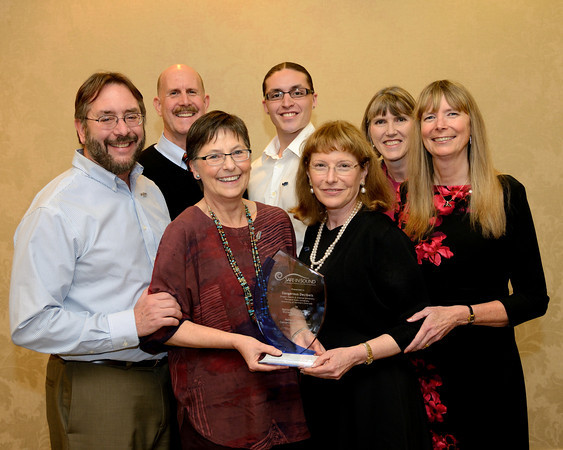
From L to R: William Hal Martin (DD), John Howard (NIOSH), Ga-Lo Vann (DD), Susan Griest (DD), Deanna Meinke (DD). L to R, front row: Linda Howarth and Judy Sobel (DD). Photo Courtesy: Jack Foreman

From L to R: back row: Pam Graydon (NIOSH, SiS), Deanna Meinke (DD), Thais Morata (NIOSH, SiS), John Howard (NIOSH), Judy Sobel (DD), Ga-Lo Vann (DD), Susan Griest (DD), Rick Neitzel (SiS), James Lankford (SiS), John Franks (SiS), Laura Kauth (NHCA). Left to right, front row: Linda Howarth (DD), William Hal Martin (DD), Andrew Perkins (VMC), Kelly Bailey (VMC), Kelly Bailey (VM), Andrew Perkins (VM). Photo Courtesy: Jack Foreman.
Colgate-Palmolive (CP) the first company to receive a Safe-in-Sound Award™ at a company level, is a global company with 35,000 employees in over 200 countries. CP manufactures dental care, personal care, home care and pet nutrition products. Their accomplishments are achieved by applying internal expertise to establish synergistic partnerships across diverse departments and organizational levels to solve problems. Colgate-Palmolive was recognized for interventions such as: company-wide adoption of the NIOSH recommended 85-dBA threshold-limit value for 8-hour noise exposures; application of the 3-dB exchange rate for noise exposure assessments; adoption of inclusive criteria in their hearing loss prevention program; completion of multiple noise-control studies throughout each business unit to identify all noise sources affecting worker exposure; development and implementation of many pilot-program noise control measures; documentation of cost and noise reduction results; dissemination of an internal CP handbook on noise control; development of online, on-demand webcast training in noise control engineering available in six languages; establishment of checklists for sustaining low-noise levels; and the adoption of buy-quiet and design-quiet policies – even to the point of assisting equipment manufacturers in developing quieter machinery.
Colgate-Palmolive Presentation (PDF Reader Required)

From L to R: Eric Oliver (CP), Chris Miller (CP), CAPT. Margaret Kitt (NIOSH), Marie Capdevielle (CP), Lori Michelin (CP), Jeff Giesse (CP), Brent Hylton (CP)
Photo Courtesy: Jack Foreman
3M, Hutchinson, MN (Hutchinson, MN). 3M has 180 plant locations worldwide which produce over 50,000 products. The Hutchinson Plant is the largest of 28 3M manufacturing facilities in the U.S. and manufactures a range of pressure sensitive adhesive tapes, micro abrasives, and coated and uncoated plastic films. The plant serves 26 of the 35 3M divisions with final products or intermediaries that are further processed for Aerospace, Automotive, Electrical, Personal Care, Communication Markets, and Renewable Energy. The hearing conservation program at 3M Hutchinson was recognized for its all-inclusive and strongly integrated approach to worker hearing health including statistically driven noise exposure assessments, implementation of a Buy-Quiet program, and noise control for existing equipment. In addition, it was recognized for comprehensive implementation of hearing protection fit-testing of all plant personnel, availability of both general and specialty hearing protection devices for off-the-job noise exposures (e.g. hunting and target shooting), high quality audiometric testing with professional supervision and evidence of strong support from corporate management, plant management and individual workers. This 3M program was tailored for individualized training and development of a culture of personal responsibility to maintain noise controls, identify noise hazards and properly fit and utilize hearing protectors throughout the facility.
3M hutchinson Plant Presentation (PDF Reader Required)
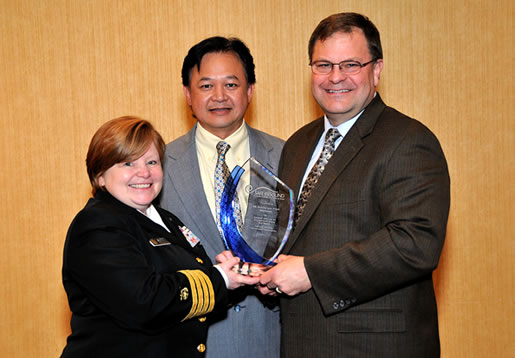
From L to R: CAPT. Margaret Kitt (NIOSH), Hendra Harapan (3M) and Dan Westrum (3M)
Photo Courtesy: Jack Foreman
Bechtel National Inc., BSII, Waste Treatment & Immobilization Plant Project (Richland, WA). (Richland, WA). The Hanford Waste Treatment and Immobilization Plant (WTP) is the world’s largest radioactive waste treatment plant. It is being designed, constructed, and commissioned by Bechtel National, Inc. The construction site spans 65 acres and includes four major nuclear facilities. Bechtel Waste Treatment & Immobilization Plant Project was recognized for the comprehensive integration of their hearing loss prevention program components, for their innovative strategies to address industry specific challenges in the areas of noise monitoring, risk evaluation and risk communication, for adopting the NIOSH-recommended exposure limit of 85 dB with the 3 dB exchange rate, for promoting the active involvement of the workforce in their efforts, and for encouraging the adoption of their strategies by other Bechtel sites
(FC) Bechtel National Inc. BSII Presentation (PDF Reader Required)
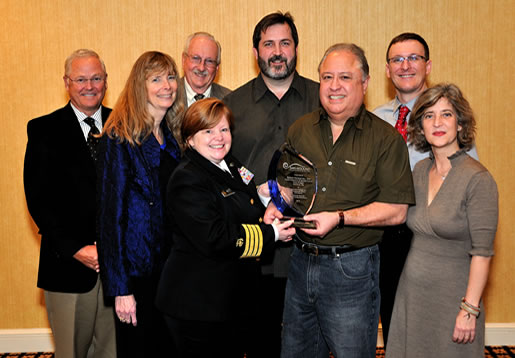
From L to R (back): Tim Rink (NHCA), Deanna Meinke (Safe-in-Sound), James Lankford (Safe-in-Sound); Scott Nickerson (Bechtel WTP), Rick Neitzel (Safe-in-Sound), CAPT. Margaret Kitt (NIOSH), Christopher Bruni (Bechtel WTP), Thais C. Morata (NIOSH, Safe-in-Sound).
Photo Courtesy: Jack Foreman
“Noise-induced hearing loss can affect workers in any sector of the workforce,” said NIOSH Director John Howard, M.D. “This year’s winners show us the power of teamwork and ingenuity in developing innovative solutions to protect workers from the home front to the front lines.”
Shaw Industries Group, Fibers Division, Plant WM, GA. Shaw Industries Group, Inc., a subsidiary of Berkshire Hathaway, Inc., is the world’s largest carpet manufacturer and a leading floor covering provider. The Division Fibers is responsible for producing the yarn needed for carpet manufacturing, an inherently noisy process. The Division Fibers was recognized for the demonstrated results in noise control, hearing loss prevention and their continuous effort to improve the quality of implementation of several of their hearing loss prevention program components: noise measurement, engineering and administrative noise control initiatives, provision of a wider selection of hearing protection devices, fit-test verification of the attenuation provided by the devices, audiometric testing, training and program evaluation, and facilitating the adoption of their strategies by other Shaw facilities.
Shaw Industries Group Presentation (PDF Reader Required)
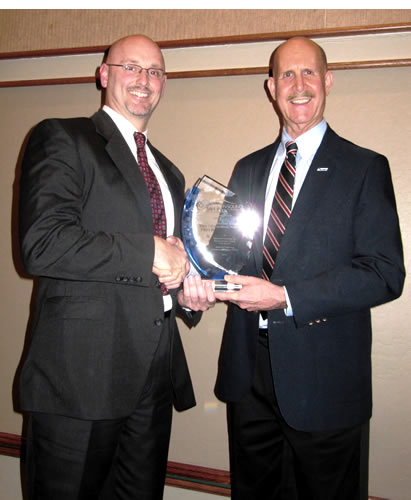
Kenny Dillard (Shaw), Dr. John Howard (NIOSH) presenting SIS Award Photo courtesy of Rick Neitzel
CPT Leanne Cleveland and the Fort Carson (FC) Army Hearing Program in Colorado Springs, CO. Fort Carson is one of the largest Army Forces Command bases. As a nation currently at war, over 26,000 Army , National Guard and Reserve soldiers were activated and demobilized from their deployments throughout the United States, Europe, and the middle east via Fort Carson in 2010.The noise hazards of war are extreme and inherently challenging to manage in terms of hearing loss prevention. Beginning in 2007, a pilot program was implemented at Ft. Carson designed to recognize the critical value of functional hearing for soldier readiness, effectiveness and safety.
CPT Cleveland (from the Army Medical Department) and the FC Hearing Program team were recognized for their innovative efforts to implement the far-reaching programatic changes outlined in Army Hearing Program (Special Text 4-02.501, 2008). The elements of this program include timely hearing testing, multi-level educational programs, hearing program officer integration, expanded hearing protection options,appropriate amplification matched to a soldier’s work-related hearing demands and an ardent commitment to each individual at risk of noise-induced hearing loss and tinnitus (civilian or soldier).Their organizational teamwork and flexibility is especially noteworthy in this high volume, time-critical work environment. The FC Hearing Program has had a direct impact on the hearing status of individual soldiers and their ability to continue to perform military duties. The pilot program outcomes have significant implications for system-wide advances in both civilian and military hearing loss prevention programs.(FC) Army Hearing Program Presentation (PDF Reader Required)
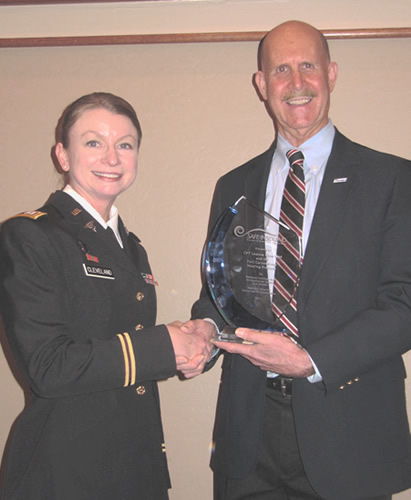
CPT Cleveland, Dr. John Howard (NIOSH) presenting SIS Award. Photo courtesy of Rick Neitzel
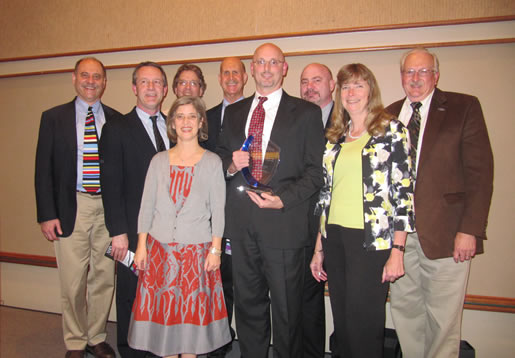
Left to Right back row: Scott Schneider (SiS), Thomas Hunterbrinker (Shaw), Lee Hager (SiS), John Howard (NIOSH) and Tim Bates (Shaw).Front row: Thais Morata (NIOSH), Kenny Dillard (Shaw), Deanna Meinke (SiS), James Lankford (SiS), Photo courtesy of Rick Neitzel
Etymotic Presentation Presentation (PDF Reader Required)
NYC Department of Evironmental Protection and Parsons Brickerhoff, Inc Presentation (PDF Reader Required)
Dr. Kris Chesky Presentation (PDF Reader Required)
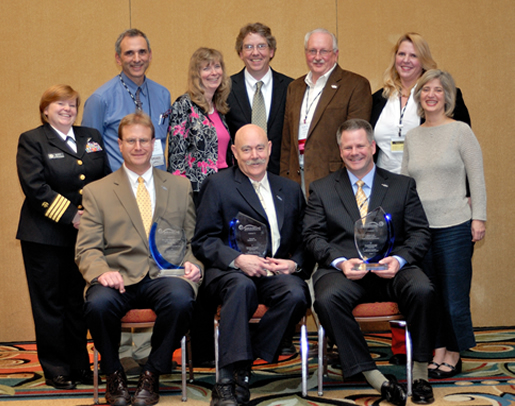
Back row, left to right: Captain Margaret Kitt and SiS Award Committee members, Noah Seixas, Deanna Meinke, Lee Hager, James Lankford, Pam Graydon, Thais Morata.
Front Row, Left to right Award Winners: Erich Thalheimer, Parsons Brinckerhoff, Inc, Mead Killion, Etymotic Research Inc., and Kris Chesky, College of Music, University of North Texas. Photo courtesy of Jack Foreman

Left to Right: CAPT, Greg Lotz, Division Director, National Institute for Occupational Safety and Health and Carter Strickland, Jr., Deputy Commissioner for Sustainability at New York City Departmentof Environmental Protection. Photo taken at the Building Trades Employers' Association Leadership Dinner, on May 18, 2010.
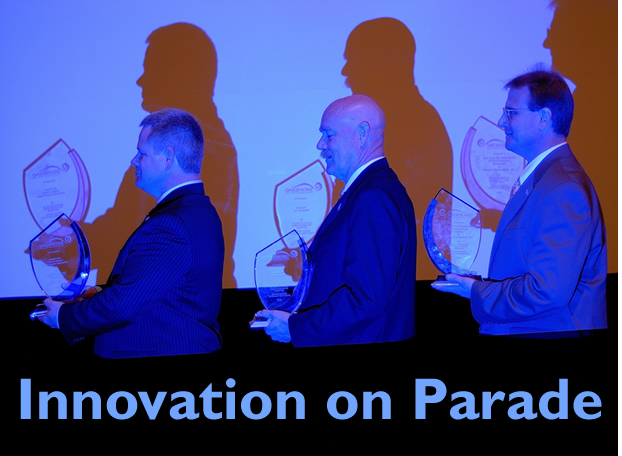
Left to right Award Winners: Kris Chesky, College of Music, University of North Texas, Mead Killion, Ph.D., Etymotic Research Inc., Erich Thalheimer, Parsons Brinckerhoff, Inc. Photo courtesy of Jack Foreman
The 2009 Safe-in-Sound Excellence in Hearing Loss Prevention Awards™ were presented at the 34th Annual Hearing Conservation Conference on February 13, 2009 in Atlanta, Georgia.
-
Pratt & Whitney - East Hartford Facility, CT. Pratt & Whitney, a United Technologies Corp. Company, is a world leader in the design, manufacture and support of aircraft engines, gas turbines and space propulsion systems. It was recognized for the comprehensive approach taken, aiming at excellence in every component of the hearing loss prevention program; for their exceptional commitment to noise control and for promoting the active involvement of the workforce in their efforts.
Pratt & Whitney Presentation (Adobe Acrobat Required) - Domtar Paper Company, Kingsport Mill, TN. Domtar Paper Company designs, manufactures, markets and distributes a wide range of fine paper products. It was recognized for the comprehensive integration of their hearing loss prevention program and a demonstrated commitment to extend hearing loss prevention practices beyond the occupational work environment into recreational and community activities enjoyed by their workers and their families.
Domtar Paper Company Presentation (PDF Reader Required)
The Montgomery County Water Services Presentation (PDF Reader Required)
Sensaphonics Hearing Conservation Presentation (PDF Reader Required)
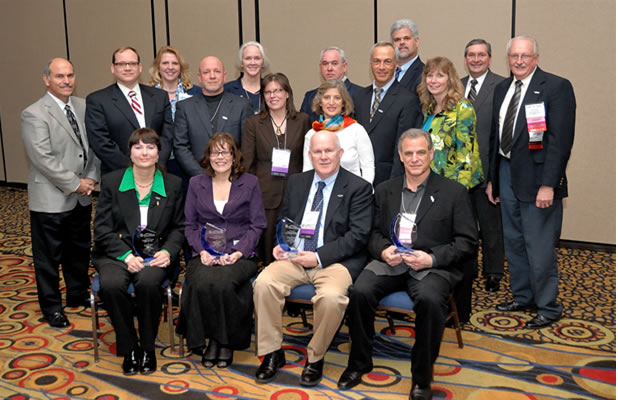
Back row, top left to top right: Charlie Floyd (Domtar), Mark Skripol (P&W), Pam Graydon (NIOSH), Tim Brooks (P&W), Nancy Hitchins (P&W), Meg Gildea (P&W), Ed Nelson (P&W), Thais Morata (NIOSH), Dom Chiulli (P&W), Craig Thompson (P&W), Deanna Meinke (NHCA), Jim Newhall (NIOSH) and James Lankford (NHCA)Front row (seated), left to right: Connie Muncy (MCWS), Debbie Davis (Domtar), Dave Russel (P&W) and Michael Santucci (Sensaphonics). Photo courtesy of Jack Foreman.
